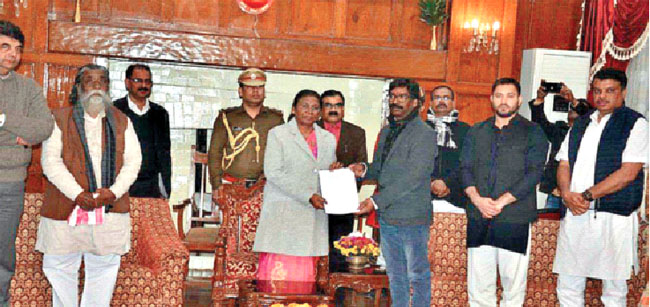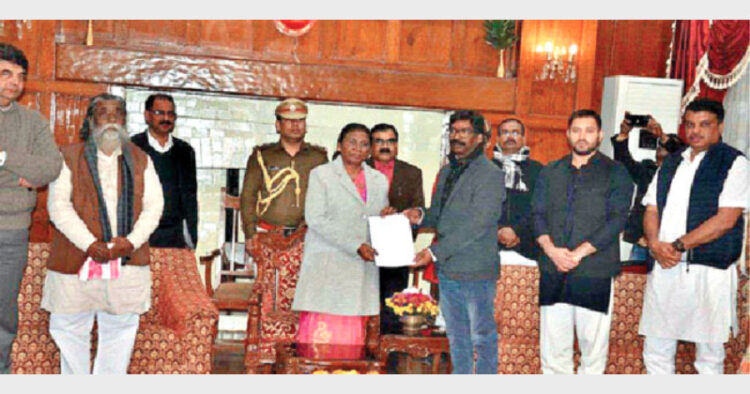
Jharkhand Mukti Morcha working president Hemant Soren staking claim to form
the government in the state
the government in the state
The ‘Resident forces’ in Jharkhand worked overtime to de-stabilise the BJP government in the last five years. However, the state government managed fairly well, though it lost the final battle to personal egos and ineffective messaging
Prashant Pandey
The BJP’s defeat in recent Jharkhand assembly polls raises serious questions over the handling of its election management and messaging the issues, rather than over the referendum on its performance on the ground. While the regional force, Jharkhand Mukti Morcha (JMM), in alliance with the Indian National Congress (Mahagadbandhan) secured a comfortable majority, Chief Minister Raghubar Das lost his own seat, Jamshedpur-East, from where he was five-time MLA. His long-time colleague, Saryu Roy, a minister in his cabinet, turned his ‘slayer’, contesting as an independent against him. Das has become the favourite whipping boy of all and sundry.
In hindsight, electoral statistics indicate that the BJP could have done better, had it cobbled up alliances with its junior partner, All-Jharkhand Students’ Union (AJSU) of Sudesh Mahato.
Electoral politics can be brutal. But there is no denying the fact that the BJP government had quite a few positives to show. By and large, it successfully dealt with the machinations of the ‘resident forces’ in the state.
First, the positives!
(i) First-ever stable government in Jharkhand in 16 years with focus on development; (ii) Naxal menace almost rooted out; (iii) Semblance of development coming to Santhal Pargana region (JMM stronghold, but reeling under extreme poverty); (iv) Hope for investment with first-ever “Global Investors Meet” in 2017; and (v) No allegations of corruption, Jharkhand’s bane. Next are the tasks that the BJP government undertook as part of its experiment to “shift the political paradigm” and, expectedly, there was a backlash from the ‘resident forces’.
A brief list: (i) Defining the “local”; (ii) Seeking to amend the Tenancy Acts, commonly known as CNT/SPT Act; (iii) Bringing law banning religious conversion through coercion or allurement; (iv) Inquiry against the Missionaries of Charity for allegedly selling children from its shelter homes; (v) mob-lynching in the name of Gaurakshaks and mob-killing people on suspicion of “child-lifting”; and, (vi) Patthalgari.
In 2016, when Raghubar Das took a decision to define a ‘local’, he was actually striking at the very root of politics that had existed since Jharkhand’s inception in 2000. The ‘Outsider vs Insider’ issue was one of the main issues in its initial few years when it had witnessed a spiral of violence and had remained a ‘touchy’ issue.
When the amendments to the CNT/SPT Act which sought to give the control of the tribal over the use of their land, were introduced, there was expected protest from the opposition. But, barring a few statements or creating ruckus in the Assembly, they did precious little. It was the so-called civil society organisations ‘for tribal causes’, who led the charge on the road, against these proposed amendments, which were later withdrawn.
The BJP MLAs themselves developed cold feet in most cases, wanting their own government to reconsider it. The government backtracked, though after much dilly-dallying (the Governor sat on the Bill for seven-odd months before returning it).
A spate of killings by villagers on suspicion of ‘child-lifting’, when not a single child was kidnapped anywhere, was another example of covert attempts to de-stabilise the state. This was a clear ploy to create an atmosphere against investments. Though not on record, senior intelligence police officials told this writer that some politicians were working behind the scene to exacerbate the situation.
The Church came out in the open against the state government, when the latter brought the ‘Freedom of Religion Act 2017’, banning religious conversions through either allurement or coercion and initiated inquiries into allegations of sale of children from the shelter homes of Mother Teresa’s Missionaries of Charity. (Secretary General of Catholic Bishops’ Conference of India (CBCI), Theodore Mascarenhas wrote to the Prime Minister seeking Das’ removal. He was the first one to be presented with a bouquet by Chief Minister-designate Hemant Soren; the occasion for Christmas becoming a timely camouflage.)
In 2016, two major incidents of mob lynching by so-called ‘Gau Rakshaks’ in Latehar and Ramgarh created nationwide furore, with mainstream media going hammer and tongs at the national/world level painting the state as a ‘hub of lynching’. The state government did well to ensure conviction in both the cases in record time.
The ‘crowning glory’, as it were, was the ‘Patthalgari’ movement. People involved in growing opium and Naxal elements, with the Church again allegedly playing from behind-the-scenes, began blocking the entry of government officials and, even ‘outsiders’, from entering villages in districts like Khunti, Simdega, Chaibasa and others. The police contingents were held ‘hostage’ when they would go to remove the barricades. Wrong interpretation of Constitution was painted on stone slabs and installed across hundreds of villages.
The idea was to create a flashpoint between the state police and the local population. Virtually, the entire human rights brigade was waiting to rush in. However, the police managed to keep the situation incident-free.
It was only after the Kochang gangrape case, in which a pastor was also jailed and convicted for handing over five women, who had come to stage a street play in his school, to their rapists (all Patthalgari supporters), that the police swung into action and sent the self-styled leaders like Joseph Purti packing, besides arresting many others.
As the state moved into the election year, the Central Government pushed through some long-awaited and historic initiatives like amendment in Articles 370 and 35A in Jammu & Kashmir, Shri Ram Janmabhoomi order, and, towards the fag end, the Citizenship Amendment Act.
This is sure to have led to expected polarisation in Santhal Pargana belt, where Muslims form a dominant population in at least three to four districts, against the BJP. The problem of illegal Bangladeshi immigrants is rampant in these parts.
To sum up, there is no doubt that the ‘resident forces’, which have been driving the state politics since long and are inimical to nationalist forces were working overtime, either overtly or covertly throughout the five-year regime. Barring the CNT/SPT Act issue, Das also seemed to have done well in keeping things under control or coming up trumps (like the case of Patthalgari).
However, all the hard work was not effectively communicated and, finally, everything boiled down to only one thing: Das’ personality. The question is wide open, as to whether the wrong person was chosen for the task, or it was a case of bad messaging.
Also, it would appear that all the rallying around the national level issues did go in vain because the matter was closer home – with personal egos being involved and nobody to soothe the ruffled feathers.
One of the prominent messages doing the rounds of WhatsApp groups, and also heard on TV quite often, was: “Bring BJP back, but not Raghubar”. It would appear that, in trying to do that, the BJP supporters have proverbially thrown ‘the-baby-in-the-bath-water’.
Meanwhile, the task for BJP in the state is well cut out. Will it allow the state to remain in the clutches of the ‘resident forces’ again for a long period, or try and wrest the initiative within the next five years?













Comments